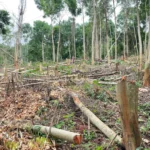
Ghana’s forest cover is undergoing degradation driven largely by mining activities, according to new findings presented at the 28th Annual General Meeting of the Ghana Institute of Foresters in Kumasi.
The event, held at the Amonoo-Neizer (IDL) Conference Centre at KNUST, focused on the theme: “Foresters at the Forefront of Change: Tackling Mining Challenges and Advancing Forest Restoration.”
A spatial analysis covering the period 2015 to 2024 revealed a marked shift from closed forests to more fragmented, open forest cover. The data show that open forests increased from 4,352,697 hectares to 5,370,518 hectares, while closed forests declined sharply from 1,450,873 hectares to 1,020,422 hectares. Experts at the meeting stressed that this trend reflects forest degradation, where forests lose density and ecological quality, rather than complete deforestation.
The findings also highlighted the severe impact of mining on protected forests.
Fifty reserves — including 49 forest reserves and the Bui National Park — have been affected by mining operations over the last decade. At the start of 2025, nine forest reserves were reportedly taken over by armed miners who blocked access to forestry officials. Although that number dropped to five by October, foresters warned that the situation remains alarming.
Some of the worst-hit reserves include the Apamprama Forest Reserve, Offin Shelterbelt Forest Reserve, Oda River Forest Reserve, Tano Anwia Forest Reserve, and Tano Nimri Forest Reserve.